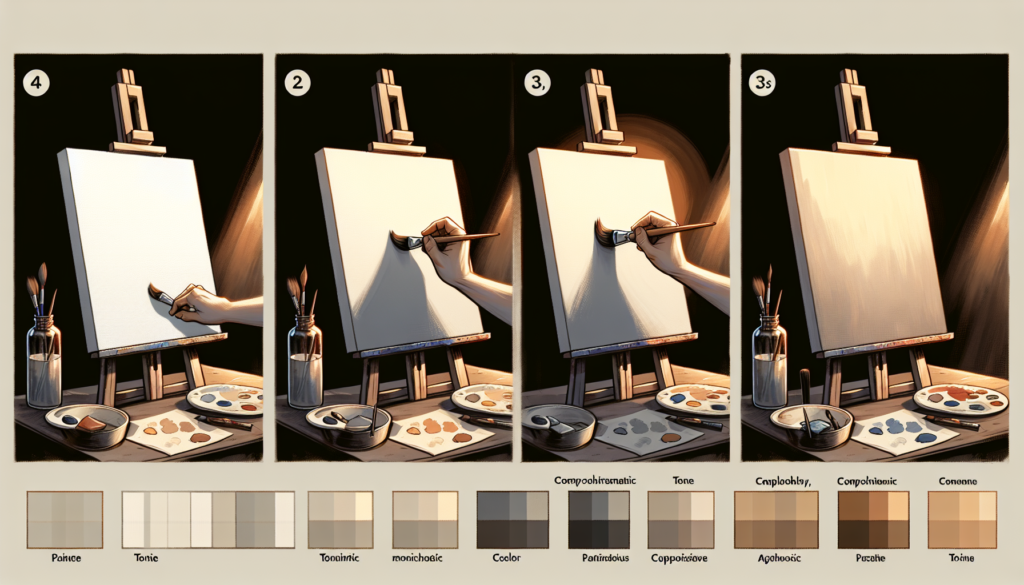In this article, you will learn the essential steps to achieve the perfect canvas for your acrylic paint. Whether you’re a seasoned artist or just starting out, understanding how to effectively tone a canvas can make all the difference in your final masterpiece. By following these simple techniques, you’ll be able to create a vibrant and harmonious backdrop that will enhance the colors and overall impact of your acrylic paintings. So grab your brushes, prepare your canvas, and let’s get started on this artistic journey together!
Materials Needed
To tone a canvas for acrylic paint, you will need the following materials:
Canvas
A canvas is the foundational surface on which you will paint. It is important to choose a canvas that is suitable for acrylic paint, as some canvases are designed specifically for oil or other mediums.
Acrylic Paint
Acrylic paint is a fast-drying paint that is water-soluble and versatile. It is available in a wide range of colors and finishes, allowing you to create various effects and textures in your artwork.
Water
Water is essential for diluting and cleaning your paintbrushes while working with acrylic paint. It helps to keep the paint flowing smoothly and allows for easier blending and layering.
Palette
A palette is where you will mix your acrylic paint colors. It can be a traditional wooden or plastic palette or simply a disposable palette pad. Having a palette ensures that you have a clean and organized space to mix your paint.
Paintbrush
A paintbrush is a tool used to apply the paint onto the canvas. There are various shapes and sizes of paintbrushes available, each serving different purposes. It is recommended to have a variety of brushes to accommodate different painting techniques.
Rag or Paper Towel
A rag or paper towel is useful for cleaning and wiping off excess paint from your brushes. It is also handy for blotting or dabbing your brush to create textured effects on the canvas.
Preparing the Canvas
Before you start painting, it is essential to prepare the canvas properly. This involves two main steps: stretching the canvas and priming the canvas.
Stretching the Canvas
Stretching the canvas ensures that it is taut and eliminates any wrinkles or sagging. This step is crucial for creating a smooth painting surface and preventing unwanted distortions in your artwork.
To stretch a canvas, you will need a stretcher frame, which is a wooden frame that holds the canvas in place. Select a stretcher frame that matches the size of your canvas.
Begin by unrolling the canvas and laying it flat on a clean surface, ensuring that there are no creases or folds. Place the stretcher frame on top of the canvas and align it with the edges.
Starting from the center, staple or tuck one side of the canvas onto the stretcher frame. Gradually work your way to the corners, pulling the canvas taut as you go. Repeat the process on the opposite side, making sure to maintain an even tension across the canvas.
Once both sides are secured, move to the remaining two sides and repeat the stretching process. Ensure that the canvas is evenly stretched and there are no loose or sagging areas.
Priming the Canvas
Priming the canvas is essential for creating a suitable painting surface. It involves applying a layer of gesso, a primer that seals the surface of the canvas and provides a smooth, absorbent base for the acrylic paint.
Before applying the gesso, ensure that the stretched canvas is clean and free from dust or debris. Use a soft, dry cloth or brush to remove any loose particles.
To choose the right gesso, consider the type of surface you prefer to paint on. Gesso comes in different variations, such as white gesso, black gesso, clear gesso, and tinted gesso. Each type has its unique qualities and effects on the final painting.
Apply the gesso using a clean, dry brush or a palette knife. Start by mixing the gesso thoroughly to ensure an even consistency. Pour a small amount of gesso onto the palette and pick up a moderate amount with your brush.
Apply the first coat of gesso evenly over the entire canvas using long, smooth strokes. Ensure that the gesso covers the entire surface, including the edges. Allow the first coat to dry completely before applying additional coats.
Depending on your painting preferences, you may choose to apply additional coats of gesso to achieve a smoother and more absorbent surface. Sand the canvas lightly between coats to remove any imperfections and create a smooth base for the paint.

Choosing the Right Gesso
Understanding gesso and its properties can help you choose the appropriate type for your canvas and painting style.
Understanding Gesso
Gesso is a primer that prepares the canvas for painting. It provides a barrier between the canvas and the paint, preventing the paint from seeping into the fabric and compromising its integrity. Gesso also adds texture to the surface, allowing the paint to adhere better.
Types of Gesso
There are several types of gesso available, each with its unique characteristics and purposes.
-
White Gesso: White gesso is the most commonly used type. It provides a smooth, matte finish and works well with most acrylic paints. White gesso is versatile and can be tinted with acrylic paint to create a colored base.
-
Black Gesso: Black gesso creates a rich, opaque surface and is particularly useful for painting subjects that require intense contrast or dark undertones. It can also be used to create dramatic effects and enhance the vibrancy of certain colors.
-
Clear Gesso: Clear gesso is a transparent primer that allows the natural color and texture of the canvas to show through. It is often used for mixed media artwork or when the artist wants to maintain the canvas’s original appearance.
-
Tinted Gesso: Tinted gesso comes in various colors and adds a colored base to the canvas. It can be used to create specific color harmonies or act as an underpainting for subsequent layers of acrylic paint.
Considerations for Acrylic Painting
When selecting gesso for acrylic painting, consider the texture and absorbency you desire in your artwork. Smooth gesso provides a slick surface ideal for detailed work, while a textured gesso creates more pronounced brushstrokes and adds depth to the painting.
Additionally, consider the thickness of the gesso. Some gessos are thicker and can be used to create impasto effects, where the paint is applied thickly and creates a textured, three-dimensional surface. Thinner gessos, on the other hand, create a smoother, more even surface.
Applying the Gesso
Once you have chosen the appropriate gesso for your canvas, it’s time to apply it.
Preparing the Gesso
Before applying the gesso, ensure that it is well-mixed to achieve an even consistency. Stir or shake the gesso thoroughly to blend any settling particles. If necessary, add a small amount of water to adjust the consistency to your preference.
Applying the First Coat
Start by pouring a small amount of gesso onto the palette. Dip your brush into the gesso and wipe off any excess on the palette’s edge. Apply the gesso to the canvas using long, horizontal or vertical strokes.
Ensure that the gesso covers the entire surface evenly, including the corners and edges. Use a brush that is suitable for the size of your canvas, as larger brushes are more efficient for covering larger areas, while smaller brushes are ideal for detail work.
Applying Additional Coats
If desired, apply additional coats of gesso to create a smoother and more absorbent painting surface. Allow each coat to dry completely before applying the next one. Sand the canvas lightly between coats to remove any imperfections and create a smooth base for the paint.

Applying the Toning
After priming the canvas with gesso, you may choose to apply a toning layer to alter the canvas color and enhance the overall painting’s mood or atmosphere.
Brushing Techniques
To apply the toning layer, use a clean brush or a palette knife. Pour a small amount of your chosen color onto the palette and pick up the paint with your brush. Apply the paint to the entire canvas using horizontal or vertical strokes, ensuring an even distribution.
You can experiment with different brushing techniques to achieve your desired effect. Try brushing in multiple directions, cross-hatching, or stippling to create interesting textures or patterns.
Uniformity of Toning
To create a uniform toning layer, it is crucial to apply the paint evenly across the entire canvas. Avoid leaving visible brush marks or variations in color intensity. Use broad strokes and blend the paint as necessary to achieve a smooth, consistent tone.
Drying Time
Allow the toning layer to dry completely before proceeding with your acrylic painting. The drying time can vary depending on the thickness of the toning layer and environmental factors such as temperature and humidity. It is recommended to wait at least 24 hours before starting to paint.
Toning the canvas for acrylic paint provides a solid foundation for your artwork. It prepares the surface, enhances color vibrancy, creates texture, and allows for better paint adhesion. By following the steps outlined above and experimenting with different techniques, you can effectively tone your canvas and embark on your creative journey with acrylic paint.